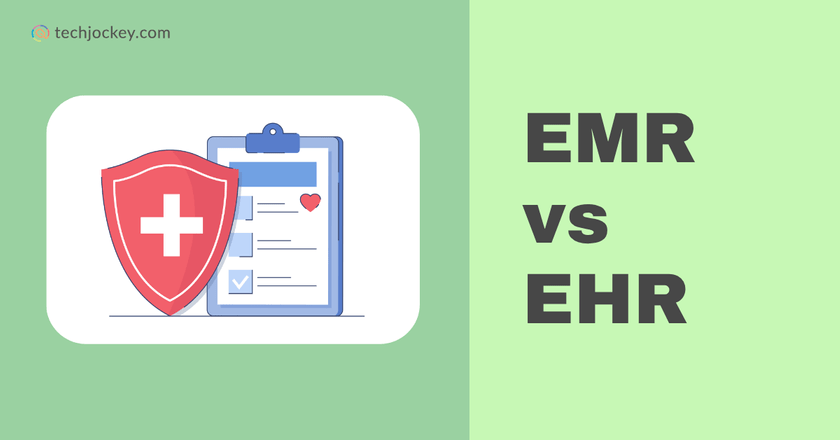Did you know that by 2025, more than 95% of hospital facilities in the U.S and 90% of working physicians will access some type of electronic record.
The two terms EMR vs EHR under electronic records are confusing many. These might seem similar terms, but they serve different purposes.
The first major step was EMRs: just digital versions of the paper charts people used to keep, in one doctor’s office. They assisted clinicians in monitoring the history, medications, and test results of patients more accurately.
But afterwards, healthcare needed something wider, and EMR vs EHR became a crucial distinction as EHRs came into existence. EHRs were developed in order to connect clinics, specialists, and hospitals together to enable them to share patient updates. Electronic health record systems today are the foundation of care coordination, patient portals, telehealth, as well as real-time data exchange.
This blog will give you a clear understanding of EHR vs EMR.
What Are Electronic Medical Records?
Electronic Medical Record (EMR) simply refers to an electronic copy of a paper chart at your local doctor. It stores common information such as your health record, conditions, prescriptions, allergies, vaccine dates, and treatment records, all in a single practice or clinic. EMRs have definite advantages compared to paper-based files:
- The doctors get a long-term record of your health data
- Can check when you need a screening or appointment
- Can quickly see trends like blood pressure or vaccinations.
There is, however, one major drawback of EMRs: they are not easy to transport outside the clinic building. Your record may have to be printed and sent by snail mail or FAX in order to be used by another specialist or hospital.
Briefly, EMRs are good for maintaining your healthcare data organized at a single doctor, but they are not designed to quickly share reports to other care centers.
Benefits of EMRs (Electronic Medical Records)
- Digitally store and organize patient charts within one clinic
- Help doctors track health data and changes over time
- Quickly spot when patients are due for preventive screenings or checkups
- Improve accuracy by reducing errors from handwritten notes
- Support better monitoring of chronic conditions within the practice
- Make it easier for staff to retrieve and update records

Medixcel EMR
Starting Price
₹ 24000.00 excl. GST
Disadvantages of EMRs
- Limited to one clinic; hard to share with other providers.
- Keeps data in silos, leading to an incomplete patient history.
- Not designed for coordinated care or patient engagement.
- Difficult and costly to scale or integrate later.
EMRs vs Paper-Based Records
Healthcare as we know it has been changed since moving from handwritten charts to electronic medical records (EMRs), yet not without trade-offs. Although the adoption of EMRs may be promising in terms of increasing accuracy and efficiency, the situation on the ground is more complicated.
The strengths of EMRs over paper records are easy to see:
- Digital records can easily be shared among the authorized healthcare professionals, and this enhances coordination and continuity of care.
- Standardized digital template narrows the chances of illegible handwriting, unclear abbreviations, or any missing information.
- EMRs can be updated more rapidly, and organized information facilitate large-scale clinical studies and even disease monitoring easier.
- Clinical decision support tools and automated alerts built into EMRs have been shown to lower complication rates, reduce mortality, and control healthcare costs.

Healthplix EMR
Starting Price
Price on Request
What are Electronic Health Records?
An Electronic Health Record (EHR) is not merely a digital version of paper charts; it is something more than that.
It holds not just basic details like history and lab results but also connects information from the patient’s entire healthcare journey. This may be insurance, demographic data, and even wearable wellness device data.
An EHR is designed to travel with you, not to be confined to one office or hospital. Your record can be accessed and updated by authorized providers such as labs, imaging centers, pharmacies, and emergency departments. The cloud-based EHR systems go a step further and allow sharing data in real-time.
As HIMSS Analytics put it, the true strength of an EHR lies in its ability to move with the patient, making your health information more useful and powerful wherever you go.

CureMD EHR
Starting Price
Price on Request
Benefits of EHRs (Electronic Health Records)
- Integrates all the health data from multiple providers, hospitals, and labs
- Makes patient records available through the cloud wherever care is needed.
- Support coordinated care by sharing information among the whole care team
- Provide patients to view their own health data through portals
- Include a broader range of information, from medical history to insurance and wellness device data
- Help improve safety and efficiency by giving every authorized provider an up-to-date view of the patient’s health
Disadvantages of EHRs
- Higher cost to implement and maintain.
- More complex, which can slow adoption and require training.
- Broader data sharing raises privacy and security risks.
- Can disrupt workflows during transition.

Therapynotes
Starting Price
$ 59.00
How EMR vs EHR systems differ?
| EMR | EHR | |
|---|---|---|
| What it is | Digital chart from one clinic | Complete digital record of your health |
| Scope | Single provider or practice | Multiple providers, hospitals, and labs |
| Purpose | Track care at one location | Coordinate and improve care across locations |
| Sharing | Rarely shared outside | Easily shared among authorized providers |
| Patient access | Often limited | Patients usually have access (patient portal) |
| Data use | Mainly for diagnosis & treatment | Patients usually have access to (patient portal) |
Is It Important to Have Electronic Records?
Absolutely! Here are reasons why electronic records, be it EMR or EHR, are important:
- Offers better care and safety: Digital records can help in reducing the chances of errors. These can be due to illegibility of handwriting or loss of paper charts. With the help of electronic records, the doctors can monitor test results, drugs, and allergies in real time. This can further help in preventing deadly errors.
- They are efficient and convenient: Using electronic records, it becomes easy to update, retrieve, and distribute patient data. With modern EHR and EMR software, this process is even faster.
- Helps in smarter decisions: Includes features such as reminder messages and alerts, and decision support. These are used to assist clinicians in adhering to good practice and identifying problems sooner before they create serious problems.
- Empower patients: Patient portals (included in most EHRs) provide the opportunity to check their laboratory reports, monitor visits, and exchange information with the care provider. This renders the patients’ partners in their respective goods.
- Give data for the bigger picture: With the help of aggregated and anonymized electronic data, researchers and public health officials can spot trends, track outbreaks, and plan better services.
Conclusion
Put simply, electronic records are not only about becoming paperless; they help in making healthcare safer, quicker, coordinated, and patient-centric.
While EMR vs EHR both digitize patient information, the real difference is bigger than it seems: EMRs are designed to keep records organized within a single clinic or practice. However, EHRs move with a patient and bridge different systems and providers.
As healthcare will continue to change, knowing the difference between EMR and EHR can enable all, including doctors and patients understand how digital tools can truly improve care.
Mehlika Bathla is a passionate content writer who turns complex tech ideas into simple words. For over 4 years in the tech industry, she has crafted helpful content like technical documentation, user guides, UX content, website content, social media copies, and SEO-driven blogs. She is highly skilled in... Read more





























